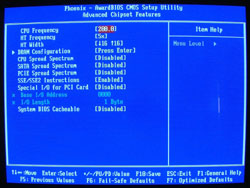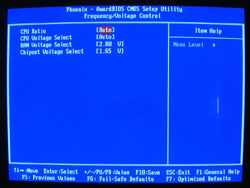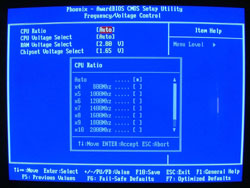BIOS and Software Setup
Note: Shuttle sent us several updated BIOS versions. The first enabled 1T command rates, but then the timings were locked at 2-3-3-5 (regardless of what you specified in the BIOS). They sent us an updated version, FN25S904.BIN, which allowed proper adjustment of the memory timings. 1T command rates have improved scores noticeably in the past, so we would recommend that anyone interested in the SN25P should make sure to get the latest BIOS from Shuttle. At present, they are up to BIOS revision FN25S906, which improves overclocking stability, but we only received that after this article was written.With the components all installed, the system is now ready to be powered up. We start by checking out the BIOS screens and features. The standard and advanced BIOS screens are pretty standard for a Phoenix/Award BIOS. Moving on to the advanced chipset features, we start to encounter some of the more interesting options.
 |
 |
| Click on images to enlarge. | |
Here, we find the controls for the CPU bus speed as well as the HyperTransport bus. A submenu contains the DRAM Timings, which are sometimes necessary in order to tune your system for optimal performance. In our system, the RAM (Samsung TCCD 2-2-2-5) was not detected properly and defaulted to 2.5-4-2-8 timings. We set it to 2-2-2-7 before continuing. (Wes' memory tests have shown a tRAS of 7 to produce the highest performance on nForce4 chipsets.)
 |
 |
| Click on images to enlarge. | |
The Frequency/Voltage screen will also be of interest to enthusiasts. The CPU bus speed can be set from 200 to 250, although even with the tested BIOS revision, we were unable to make use of most of the available settings. Serious overclockers would like the ability to run the bus at least to 300 MHz. However, before such a feature becomes meaningful, we'll need to be able to actually reach the high bus speeds. Shuttle has informed us that they are working on an updated BIOS that will allow for higher bus speeds, hopefully up to 300 MHz, but our tested version had difficulties as you'll see in our overclocking results.
We have included pictures of the remaining BIOS screens just to be complete, and those interested in seeing the other options should download the full image set.
After the BIOS is set up the way that we like it, we move on to installing Windows XP. There isn't much to talk about until the OS installation is finished - at which point, we need to install the chipset and audio drivers. Shuttle includes a CD for this purpose, along with utilities like WinFlash and Adobe Acrobat Reader 6. A second CD includes a copy of Trend Micro PC-cillin 2004 Internet Security - an anti-virus and firewall program - along with Muvee autoProducer 3.1 CE, a video editing package. We didn't really pay much attention to the Muvee product, but Trend Micro is a well-known anti-virus firm, and a free copy of their software is a decent extra. It is a full year subscription, which is even better, as opposed to a 30 or 90 day trial version.
Worth noting is that the audio drivers by default do not run in hardware accelerated mode. In order to activate this, open the VIA Envy control panel, click the "Advanced" tab, and check the box for "Sound Effects/3D Gaming Support". It will be necessary to reboot the system for this to take affect. If you fail to do this, sound in several games loses some of the advanced 3D effects. 3DMark03/05 will also disable the audio acceleration tests and report the hardware as being capable of supporting 0 hardware accelerated 3D streams. Once you've enabled the feature, you will get the proper sound support, and the drivers will report the ability to accelerate 64 3D audio streams.
That takes care of the system setup. After installing our standard benchmarking software, we're ready to see how the system actually performs in day-to-day use.










30 Comments
View All Comments
JarredWalton - Wednesday, March 9, 2005 - link
Feeling a little melodramatic, are we Grug? "5X and look terrible." Yes, and we're looking at massive 50K file sizes. The larger JPG was provided from Shuttle, so converting it to a different format would have reduced the size, but it wouldn't have improved the quality. In the future, I'll be sure to use GIF/PNG for such screenshots, but given that we're only saving 120KB of size for the whole article, it's not a big deal.As a side commentary: If you're surfing on a modem, each page of AnandTech (with ads) would still come in at about 170K without any additional images. The entire article with thumbnails comes to about 1.2 MB, and the size of all 12 pages with additional layout data would be around 3 MB. An increase of 3% or less in total content size (not even counting the higher resolution images). I don't see why anyone would notice or care.
As it stands, I don't have the original screen captures, so we're stuck with the gigantic JPG images that show compression artifacts when you zoom in to 200% or more. Sorry.
grug2k - Wednesday, March 9, 2005 - link
Ugh. Please use 8-bit PNG or GIF for your CPU-Z screenshots and the like. Those JPEGs are 5x the size and look terrible.JarredWalton - Wednesday, March 9, 2005 - link
re: #17 - Updated nForce4 informations:The nF4 Standard version does not support SATA-II and there is supposedly a mintor difference in the networking controller. Nothing major relative to the Ultra, I'd say.
JarredWalton - Wednesday, March 9, 2005 - link
Remember that the relative size of this case isn't that bad. It's about the same as the Soltek cases, and is roughly 1" longer, wider, and taller than the G5 XPC chassis. Are people really that concerned about an extra inch? I'm not.The lack of a PCI slot is something of a problem for now. If you can get a PCIe card with VIVO, you can get around that limitation, but that's about all I can say for now. Are there *any* X1 PCIe cards on the market yet? I'm not aware of any, and after almost a year of existence that's rather telling. NICs will probably be the first thing to show up, but more people are interested in audio and TV-tuner than in network support, I think.
Finally, I was incorrect in my classification of the chipset. It is actually the "nForce4 Standard", which is not a version I had heard of until now. Aparently it adds official 5X HT support and the hardware firewall. Really, I'm not entirely sure how it's different from the Ultra. The article is updated with this information.
arswihart - Wednesday, March 9, 2005 - link
it is nice, but I really appreciate an SFF when its as small as, say the Zen st62k, which I bought for my parents.When an sff gets to the size and price of this sn25p, it gets harder to choose this rather limiting and relatively expensive alternative to a standard ATX case with quiet cooling.
eastvillager - Wednesday, March 9, 2005 - link
I think the price is fine, just look at what you get, lol.Custom case, nf4 mobo, custom 350watt ps, drive cables, heatsink/pipe, 5 fans, etc.
This isn't the box you use to build your pvr, so don't worry about no pci slots for a tv tuner. If you want to build a pvr/htpc/etc., pick a smaller box.
Nice review, btw. :-)
GoatHerderEd - Wednesday, March 9, 2005 - link
#13 and everyone complaining about price: Shuttle can demand that price. They were the first, and they have some of the best quality or at least perceived quality. If people wouldn’t buy at that price, it wouldn’t be that high.I don’t see you complaining about Intel Prices, it is a very similar pricing strategy.
WooDaddy - Wednesday, March 9, 2005 - link
$400+ is the killer for me.. I think Shuttle is losing sight here..Jarod, let us know when you update those graphs. That's the real kicker for most of us here too. Subjective audio analysis doesn't really do it for me. BTW, just your personal opinion.. is it still safe to go AGP for the next 2+ years?
What I'd LOVE to see is a version of the Kloss KL-I915A with socket 939 and Nf4. Check out http://www.klosspc.com/ and you'll see what I mean..
Hell even the Asus S-presso would be nice..
arswihart - Wednesday, March 9, 2005 - link
i think it would have been better to have a pci slot than a pcie slot, thats really the worst thing about this sff imosideshow23bob - Wednesday, March 9, 2005 - link
Is anyone else concerned about the lack of PCI slots, wouldn't that be necessary to install a tv tuner, unless you went with an ALL In Wonder GPU? Do they make tuners for PCIex1?